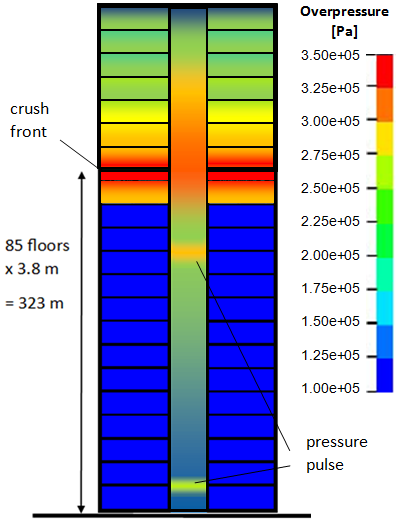To elevate the degree of research surrounding 9/11, we need to quantify the overpressures in the core and the stairways with respect to time. Why? Think about how the quantitative efforts of Szamboti, MacQueen and others have advanced research to a higher degree on the topic of the missing jolt. Qualitative descriptions are great, but we need to seal the deal on this topic of ejections quantitatively as well.
AE now has a decent number of knowledgeable mechanical and structural engineers. To refute NIST’s hypothesis of “dust puffs”, we need experts in compressible fluid dynamics (or gas dynamics) that can determine for sure if NIST’s stand holds any weight. Gas dynamics is not an easy field and CFD (computational fluid dynamics) is often used to model complex phenomena and can yield accurate results if the boundary conditions are well defined. The WTC had about 99 elevators and 3 stairways, the core was about 28% of the cross-sectional area of the towers, and the towers were about 95% air. This is certainly difficult to model. However, a simplified approach favorable to NIST’s hypothesis can, in my estimation, still show them to be incorrect.
I’m in the process of writing a proposal that will test the piston hypothesis and will obtain an estimate from CFD consultants regarding the costs of modeling the WTC. Szamboti and MacQueen determined the descent to be at about 70% of the gravitational acceleration. We can use their work to model a piston compressing air with respect to time. Having a pressure-volume curve obeying Boyle’s law would be NIST’s dream come true but it’s far from reality given the observable disintegration of Bazant’s “upper rigid block”. So a model that is an open system (with holes or assumed vent ratios in the piston and some along the perimeter of the crush front) compressing air would be best to test and see if the pressure 30 floors below the crush front was significant at all. If the overpressures are less than the breaking pressure of windows, then there is a very strong case.
A second item NIST briefly mentioned in their FAQ is that such phenomena could be due to a collapsing floor at a lower level. I think the burden rests on them to show whether a floor failed far below the crush front. Regardless, they won’t engage in the topic any more. If we wish to advance this area, we’ll just have to model it.
Also, I remember MacQueen told me about the ejections piercing through the massive corner column (diagonally outwards). After some thought, a natural explanation for this is impossible.

